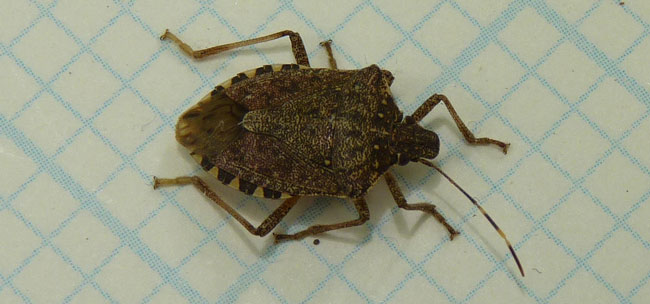Did the Polar Vortex Kill Off the Stink Bugs?
By Chris Williams on March 4, 2014.

Maybe a bit of good news from our long, cold winter. It may have done a number on brown marmorated stink bug populations. The brown marmorated stink bug is a fairly new invader to the U.S. that decimates crops and then often moves into homes to spend the winter.
Dr. Thomas Kuhar of Virginia Tech studies these stink bugs. Each fall, he and his graduate students collect stink bugs that have congregated on the outside of buildings. They put the bugs into ventilated 5-gallon buckets filled with foam insulation. The buckets are stored outside, under shelter, to simulate the normal winter environment for stink bugs. The bugs normally spend the winter in sheltered sites under bark, in tree stumps, under stones, in woodpiles, under shingles, or similar. If they’re lucky, they will find their way into homes and other buildings.
When Kuhar pulled out his stink bug buckets in mid February to start experiments, he found that 95% were dead as a result of the sustained cold weather in January. Normal winter mortality in the bug buckets is 20-25%. Stink bugs can normally survive the winter outside due to a sort of internal antifreeze that keeps their body fluids from crystallizing. The stink bugs were thought to be able to survive winter temps as low as minus 4 degrees. The lowest temperature in Blacksburg, VA in January was minus 5.
In Virginia, fruit tree growers are ecstatic about the news of the stink bugs’ untimely demise. For most of us, stink bugs are just occasional indoor annoyances, but they are serious pests for fruit growers.
What About Stink Bugs in the Northeast?
Other data suggest that a 50% stink bug mortality in some areas may be more realistic. While some stink bugs spending this winter outside may have succumbed, those in homes probably will still make their appearance soon. “How well they survive is going to depend on how clever they are in finding the right protected location.” Says Dr. Michael Raupp of the University of Maryland. “If they found the right location like my attic, they’re probably going to do just fine.”
Of course, these were Virginia stink bugs who may be less adapted to the cold anyway than our Northeastern stink bugs. Whether this winter has affected brown marmorated stink bugs in our area remains to be seen. This stink bug is now present in 38 states in the U.S. Thirty-one states, mostly in the Midwest and East, reported January temperatures below normal. And, we’re not done yet.
Stink bugs aren’t the only insects that will be affected by the polar vortex. Any insects that overwinter outside (and there are a lot of them) will likely suffer more mortality than usual in areas that have had a more severe winter than normal. Exactly how that will play out in the long term remains to be seen when spring arrives.
Photo credit: Dendroica cerulea / Foter / CC BY